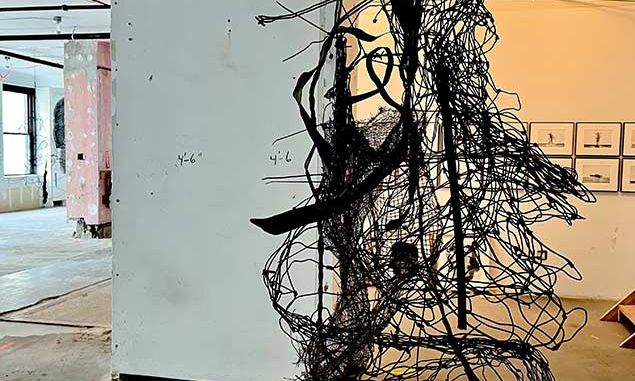One of Christopher Wool’s works in See Stop Run, in a disused New York office
Photo: Linda Yablonsky
It’s uncanny how often I hear people say how much they miss 1970s New York or wish they had lived here then. I am one of the lucky ones, but let me tell you: making your way through that grimy cesspool of crime, corruption and debauchery was not always fun. Still, the daily threat of danger created its own buzz, its own glamour. Add cheap rents, a surfeit of nightclubs and dive bars, and a surging population of young artists moving into downtown Manhattan, and you had the basic ingredients of a crackling cauldron of underground activity. With little planning or interference, artists of every stripe stole into vacant properties, abandoned buildings, creaky lofts and rotting piers to stage exhibitions and live performances made legendary by their very ephemerality. It was exciting—until money came into the picture and took the piss out of it.
Now, Christopher Wool has awakened some of the old DIY spirit with See Stop Run, a survey of recent bodies of work that he and the independent Belgian curator Anne Pontégnie have installed—legally—in a magnificently unreconstructed space on the 19th floor of an office building in the financial district.
Here, in the mercantile centre of the world, is a decidedly noncommercial exhibition of painting, photography, drawing, prints, posters and books—around 75 works in all. The show has no backing from any gallery, institution, foundation or collector. Nor is anything in it available for purchase. All belong to Wool. It’s not that he had a sudden urge to indulge in institutional critique, he just wanted to see how the surrounding context would affect works of art he usually shows in sanitised white-cube galleries and museums. As he says, “the modernist ideal in art excludes context”. (The project has its own website and is open to the public, free, until 31 July.)
Ironically, what made the show possible was the dearth of tenants for commercial real estate that followed the Covid lockdown, a situation that mirrors the open-city environment of the 70s. Wool’s intervention gains added resonance by recalling a time when the new Twin Towers of the World Trade Center were largely unoccupied, and their only residential neighbours were artists.
It took two years of looking before Wool and Pontégnie were shown the U-shaped, 19,000 sq. ft space. “The idea was to leave it a little rough,” says Pontégnie, who has worked with Wool on various projects for decades, starting with the first exhibition of his photographs; a 2022 show at Xavier Hufkens in Brussels was the impetus for See Stop Run. “This allows for something more intimate than a gallery or institution can,” she notes. “We didn’t think about any consequences. We just said, ‘do it’.”
Both artist and curator hope people will come for the exhibition and stay to hang out over coffee at tables or on the couch. I’m sure they will. The 19th floor of this half-empty building offers dazzling city and river views on five sides. It is also ruined enough to suggest an archaeological dig that exposes its previous lives at every step on the remnants of its mosaic tile floor.
A monumental mosaic of a painting that Wool made for his house in Marfa, Texas is just one of the showstopping elements of the continually surprising visual narrative that is See Stop Run. The title is a pun on one of Wool’s classic typological paintings of the 80s. None of those is here. His explosive mosaic derives from Crosstown Traffic, an even larger one commissioned for a new office building in Hudson Yards. The other works on view came out of the artist’s studios in New York and Marfa over the past five years.
All began with materials that Wool either found in the Marfa desert or upcycled from previous work, quoting from, erasing and adding layers to patterned, silkscreened-on-enamel paintings, the strategy he has employed throughout his career. Hanging from the ceiling throughout the space are seemingly delicate, mobile sculptures made of tangled barbed wire. Sculptures on plinths were cast from copper tubing. Photographic series in the rhythmic installation show individual wire sculptures or the desert landscape that has given Wool his raw materials. On columns and in nooks are works on paper. This is an exercise of an artist’s vision free of all constraints. Its effect liberates the viewer from the bland, super-expensive and tightly patrolled Ikea aesthetic that dominates the city now.
It’s not unusual to repurpose decaying architecture with art, but those efforts primarily are sponsored by self-branding commercial or institutional entities. To find an artist shouldering the entire burden, without any mediating strings, is considerably more rare—and stimulating, whether you have tasted the forbidden fruit of the do-or-die 1970s or not.
• Christopher Wool: See Stop Run, 101 Greenwich Street, 19th floor, 14 March-31 July

